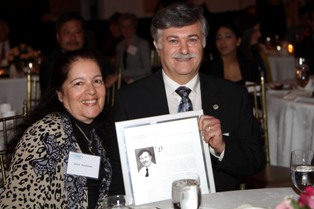FOR IMMEDIATE RELEASE – STONY BROOK, NY, March 15, 2013
Arie E. Kaufman, Distinguished Professor and Chair of the Department of Computer Science at Stony Brook University, was inducted into the Long Island Technology Hall of Fame (LITHF) for his vast accomplishments and contributions to information technology and specifically to visualization and computer graphics. Now in its 12th year, the LITHF recognizes, honors and preserves the accomplishments of current leaders in science or technology who have impacted or are having an impact on Long Island.
Dr. Kaufman, who also serves as the Director of the Center for Visual Computing (CVC) and Chief Scientist of the Center of Excellence in Wireless and Information Technology (CEWIT) at Stony Brook University, has conducted research for more than 40 years in visualization, graphics, virtual reality, user interfaces, multimedia, and their applications, especially in biomedicine. He joined the faculty of the Department of Computer Science at Stony Brook University in 1985 and was appointed Chair in 1999.
“Arie is a tremendous leader in science and technology, not only on Long Island but throughout the world,” said Yacov Shamash, Vice President for Economic Development and Dean of the College of Engineering and Applied Sciences at Stony Brook University. “His work with the virtual colonoscopy and advanced medical imaging has saved countless lives and his advances in immersive visualization provide endless possibilities for engineers, scientists and physicians to tackle the most complex problems facing us today.”

Throughout his career, Dr. Kaufman has made significant research breakthroughs and cutting-edge inventions, including the development of the 3D Virtual Colonoscopy, a technique for colon cancer screening that has saved innumerable lives; the Cube hardware architectures for real-time volume rendering which enables 3D medical imaging on PCs; and a real-time simulation and visualization of flow, especially for airborne dispersion in rural and urban environments, supporting battlefield training and homeland security. He pioneered the use of Graphics Processing Units (GPUs) and GPU-clusters, especially for accelerating simulation and visualization of flow.
In November 2012, Dr. Kaufman and his team unveiled the Reality Deck, a National Science Foundation and Stony Brook University funded 1.5 billion-pixel immersive display which is the largest resolution immersive visualization facility ever built, with the purpose and primary design to enable scientists, engineers and physicians to solve modern-age problems that require the visualization of vast amounts of data.

“I am honored to be part of the LI Technology Hall of Fame,” said Dr. Kaufman. “Knowing that the tools and devices I’ve created, have saved many lives and have improved the quality-of-life for countless others, has been my true reward.”
Dr. Kaufman's significant service to the visualization/graphics community includes serving as the founding Editor-in-Chief of IEEE Transaction on Visualization and Computer Graphics (TVCG) from 1995-1998. Dr. Kaufman was further recognized for his contributions, as he was elected to the highest level of a Fellow of IEEE "for contributions to and leadership in visualization and computer graphics," an ACM Fellow "for seminal contributions to and leadership in visualization, especially in volume visualization and its applications," and received the prestigious IEEE Visualization Career Award “for seminal work in the theory and practice of volume visualization."
Dr. Kaufman received a BS in Mathematics and Physics from the Hebrew University of Jerusalem, Israel; an MS in Computer Science from the Weizmann Institute of Science, Rehovot, Israel; and a PhD in Computer Science from Ben-Gurion University, Israel. He has published in excess of 300 refereed papers, more than 250 conference presentations, and has been awarded/filed more than 40 patents, most of which have been licensed. He has been a principal/co-principal investigator on more than 100 research grants. His work has been featured globally in numerous media communications.

